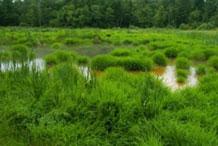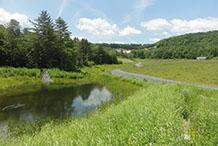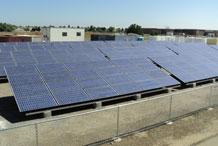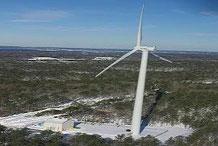Examples of Greener Cleanups
State-of-the-art technologies, novel field methods, and "tried and true" design and engineering techniques can be combined to address the core elements of a greener cleanup.
On this page:
- Greener cleanups under various programs
- Green remediation profiles
- Sustainable redevelopment of remediated sites
Greener Cleanups Under Various Programs
Best management practices (BMPs) are in place under a range of cleanup programs including Superfund, RCRA, federal facility, brownfield, and state voluntary actions.
 De Sale Restoration Area after cleanup relying on passive flow of water through treatment units.De Sale Restoration Area, Slippery Rock Watershed, Pennsylvania
De Sale Restoration Area after cleanup relying on passive flow of water through treatment units.De Sale Restoration Area, Slippery Rock Watershed, Pennsylvania
Using alternative treatment techniques, a Pennsylvania non-profit group coordinated conversion of an abandoned coal mine to a natural resource conservation area. A series of natural gradient-driven engineering steps involving settling ponds, vertical-flow ponds and constructed wetlands are used to passively neutralize 180 pounds of acid discharge per day. Approaches for sustainable materials management include using spent mushroom compost rather than virgin resources as water treatment media and recovering mining-associated manganese and iron oxide waste with economic value as industrial organic pigments.
Elizabeth Mine, South Stratford, Vermont
Construction of remedial systems to restore surface water affected by acid rock  Stormwater drainage channel and retention basin at the Elizabeth Mine site.drainage relied on use of advanced diesel technologies for heavy machinery, alternative fuels, fuel conservation practices, maximized reuse of onsite materials, a recycling program and procurement of environmentally preferable products. Environmentally friendly approaches to stormwater management involved using biodegradable rather than synthetic sandbags, substituting silt fences with more effective tubular devices containing organic materials, and installing water diversion structures that follow the site’s natural contours and drainage patterns. Techniques to construct the remedial components, including an extensive landfill, also strived to quickly restore the site to its natural conditions and improve the site’s ecosystem services.
Stormwater drainage channel and retention basin at the Elizabeth Mine site.drainage relied on use of advanced diesel technologies for heavy machinery, alternative fuels, fuel conservation practices, maximized reuse of onsite materials, a recycling program and procurement of environmentally preferable products. Environmentally friendly approaches to stormwater management involved using biodegradable rather than synthetic sandbags, substituting silt fences with more effective tubular devices containing organic materials, and installing water diversion structures that follow the site’s natural contours and drainage patterns. Techniques to construct the remedial components, including an extensive landfill, also strived to quickly restore the site to its natural conditions and improve the site’s ecosystem services.
 Onsite solar farm that offsets utility power used at the Frontier Fertilizer site.Frontier Fertilizer Superfund Site, Davis, California
Onsite solar farm that offsets utility power used at the Frontier Fertilizer site.Frontier Fertilizer Superfund Site, Davis, California
An onsite photovoltaic system that covers half an acre offsets 100% of the non-renewable energy needed to treat the site’s contaminated groundwater; use of this system is anticipated to reduce indirect emission of carbon dioxide (equivalent) by approximately 119,000 pounds each year over 20 years. Optimized energy consumption has included equipping the groundwater extraction pumps with variable frequency drives and replacing the electrical pump used for treated water discharge with an alternate gravity-feed pipe system. The project team is also evaluating options for reusing the treated groundwater to irrigate nearby municipal properties.
Massachusetts Military Reservation (MMR), Cape Cod, Massachusetts
 MMR's 1.5 MW wind turbine for offsetting energy used to extract and treat groundwater.Efforts to minimize consumption of energy, water, and other natural resources and streamline activities during long-term cleanup at this federal facility involve: periodic optimization of the existing systems for groundwater extraction and treatment; implementing energy conservation techniques such as use of occupancy sensors and programmable thermostats in buildings; conducting soil and water sampling through minimally invasive techniques such as employing direct-push equipment rather than conventional rotary drills and relying on passive samplers requiring no pumping or purging; and operating a large-scale renewable energy system to offset the high rates of onsite electricity consumption and associated air emissions from power plants.
MMR's 1.5 MW wind turbine for offsetting energy used to extract and treat groundwater.Efforts to minimize consumption of energy, water, and other natural resources and streamline activities during long-term cleanup at this federal facility involve: periodic optimization of the existing systems for groundwater extraction and treatment; implementing energy conservation techniques such as use of occupancy sensors and programmable thermostats in buildings; conducting soil and water sampling through minimally invasive techniques such as employing direct-push equipment rather than conventional rotary drills and relying on passive samplers requiring no pumping or purging; and operating a large-scale renewable energy system to offset the high rates of onsite electricity consumption and associated air emissions from power plants.
Green Remediation Profiles
EPA’s Office of Superfund Remediation and Technology Innovation offers more than 30 site-specific profiles of projects using the BMPs to improve environmental outcomes of cleanup. Each project applies a tailored strategy to address the core elements of a greener cleanup while continuing to meet remedial goals. The projects involve diverse technologies for site remediation and are implemented under a range of cleanup programs, including Superfund, RCRA, brownfields, or voluntary actions under state oversight.
Sustainable Redevelopment of Remediated Sites
Outcomes of greener cleanups are optimized by linking green remediation strategies with plans for future use of a site, which may involve redevelopment. EPA's Superfund Redevelopment Initiative cleanup partners possess the processes, tools and information needed to return a Superfund site to productive use. EPA's Brownfields and Land Revitalization Program offers reports and fact sheets highlighting lessons learned from pilot projects and describing the Program's initiative to bring greener cleanup approaches to brownfield assessment, cleanup and redevelopement.
